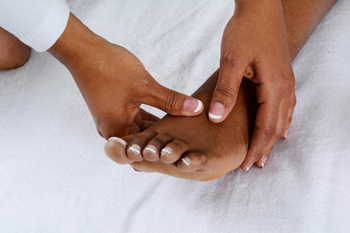 Gout is an inflammatory form of arthritis that can cause swelling and stiffness in the joints, most commonly affecting the big toe. A common symptom of gout may include sudden flare ups, where the joints of the big toe begin to experience a throbbing, crushing pain. If your joints appear swollen or inflamed, and the skin of the affected area is warm and appears red or purplish, you may be experiencing symptoms of gout as well. Symptoms of gout can generally be managed by certain lifestyle changes as well as medication, however getting this condition diagnosed can sometimes be difficult. If you’re experiencing joint pain, particularly in your big toe, please seek the professional care of a podiatrist for a proper diagnosis.
Gout is an inflammatory form of arthritis that can cause swelling and stiffness in the joints, most commonly affecting the big toe. A common symptom of gout may include sudden flare ups, where the joints of the big toe begin to experience a throbbing, crushing pain. If your joints appear swollen or inflamed, and the skin of the affected area is warm and appears red or purplish, you may be experiencing symptoms of gout as well. Symptoms of gout can generally be managed by certain lifestyle changes as well as medication, however getting this condition diagnosed can sometimes be difficult. If you’re experiencing joint pain, particularly in your big toe, please seek the professional care of a podiatrist for a proper diagnosis.
Gout is a foot condition that requires certain treatment and care. If you are seeking treatment, contact the podiatrists from Boston Common Podiatry. Our doctors will treat your foot and ankle needs.
What Is Gout?
Gout is a type of arthritis caused by a buildup of uric acid in the bloodstream. It often develops in the foot, especially the big toe area, although it can manifest in other parts of the body as well. Gout can make walking and standing very painful and is especially common in diabetics and the obese.
People typically get gout because of a poor diet. Genetic predisposition is also a factor. The children of parents who have had gout frequently have a chance of developing it themselves.
Gout can easily be identified by redness and inflammation of the big toe and the surrounding areas of the foot. Other symptoms include extreme fatigue, joint pain, and running high fevers. Sometimes corticosteroid drugs can be prescribed to treat gout, but the best way to combat this disease is to get more exercise and eat a better diet.
If you have any questions please feel free to contact our office located in Boston, MA . We offer the newest diagnostic and treatment technologies for all your foot and ankle needs.






 Athlete’s foot
Athlete’s foot






